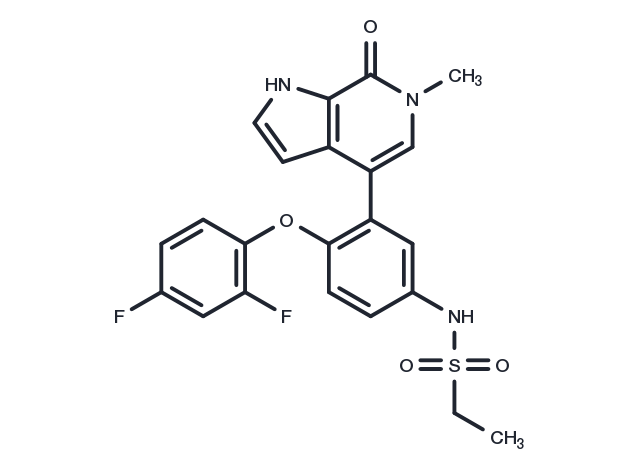Powder: -20°C for 3 years | In solvent: -80°C for 1 year


Mivebresib (ABBV-075), also known as ABBV-075, is a potent BET inhibitor (bromodomain (BRD)-containing protein) with potential antineoplastic activity. Upon administration, the bromodomain inhibitor ABBV-075 binds to the acetyl-lysine binding site in the BRD of certain BRD-containing protein(s), thereby preventing the interaction between those proteins and acetylated histones. This disrupts chromatin remodeling, prevents the expression of certain growth-promoting genes, and leads to an inhibition of cell growth in susceptible tumors. Also a potent inhibitor of MYC and the TMPRSS2-ETS fusion proteins.

| Pack Size | Availability | Price/USD | Quantity |
|---|---|---|---|
| 1 mg | In stock | $ 53.00 | |
| 2 mg | In stock | $ 75.00 | |
| 5 mg | In stock | $ 98.00 | |
| 10 mg | In stock | $ 162.00 | |
| 25 mg | In stock | $ 270.00 | |
| 50 mg | In stock | $ 486.00 | |
| 100 mg | In stock | $ 695.00 | |
| 1 mL * 10 mM (in DMSO) | In stock | $ 100.00 |



| Description | Mivebresib (ABBV-075), also known as ABBV-075, is a potent BET inhibitor (bromodomain (BRD)-containing protein) with potential antineoplastic activity. Upon administration, the bromodomain inhibitor ABBV-075 binds to the acetyl-lysine binding site in the BRD of certain BRD-containing protein(s), thereby preventing the interaction between those proteins and acetylated histones. This disrupts chromatin remodeling, prevents the expression of certain growth-promoting genes, and leads to an inhibition of cell growth in susceptible tumors. Also a potent inhibitor of MYC and the TMPRSS2-ETS fusion proteins. |
| Targets&IC50 | BET:1.5 nM(ki) |
| In vitro | ABBV-075 exhibits robust single agent activity in cell viability assays across cancer cell lines derived from solid tumors, leukemia and lymphomas. It could disrupt cell cycle control leading to G1 arrest followed by senescence, inhibit oncogenesis drivers leading to apoptosis, and potentially target tumor microenvironment to provide additional therapeutic benefit[1]. |
| In vivo | ABBV-075 has comparable or superior efficacies to standard of care agents in flank xenograft mouse models of non-small-cell and small cell lung cancers, pancreatic, breast, prostate, head & neck cancers, multiple myeloma, diffuse large B cell lymphoma and leukemia[1]. |
| Synonyms | ABBV-075 |
| Molecular Weight | 459.47 |
| Formula | C22H19F2N3O4S |
| CAS No. | 1445993-26-9 |
Powder: -20°C for 3 years | In solvent: -80°C for 1 year
H2O: < 1 mg/mL (insoluble or slightly soluble)
Ethanol: < 1 mg/mL (insoluble or slightly soluble)
DMSO: 84 mg/mL (183 mM)
You can also refer to dose conversion for different animals. More
bottom
Please see Inhibitor Handling Instructions for more frequently ask questions. Topics include: how to prepare stock solutions, how to store products, and cautions on cell-based assays & animal experiments, etc.
Mivebresib 1445993-26-9 Apoptosis Chromatin/Epigenetic Epigenetic Reader Domain ABBV-075 ABBV 075 ABBV075 Inhibitor inhibit inhibitor
